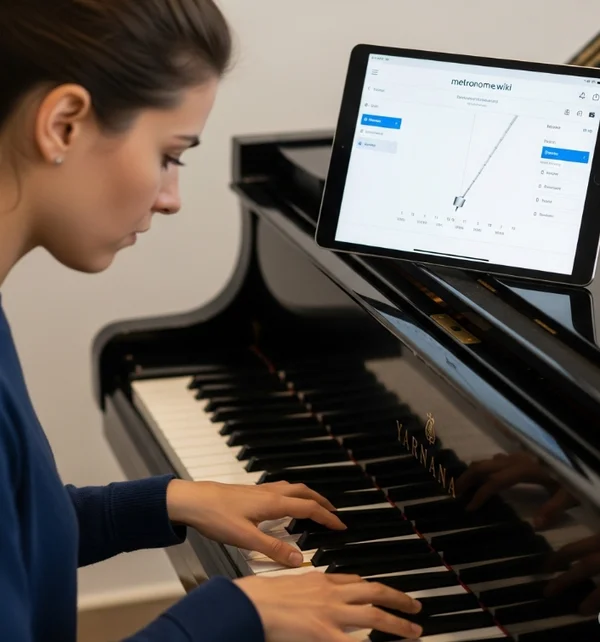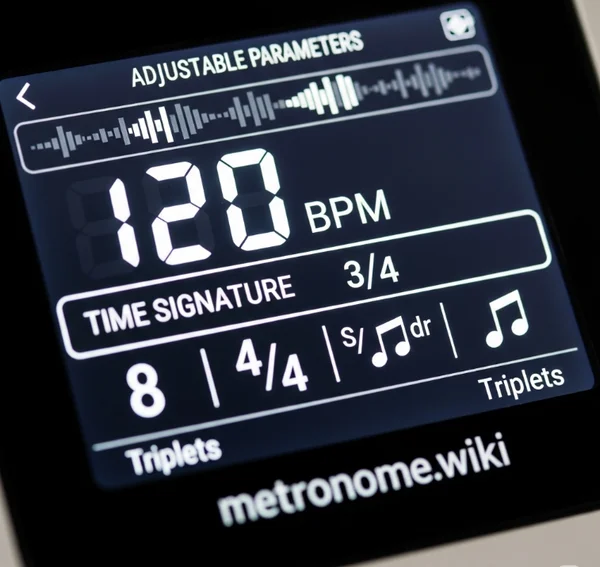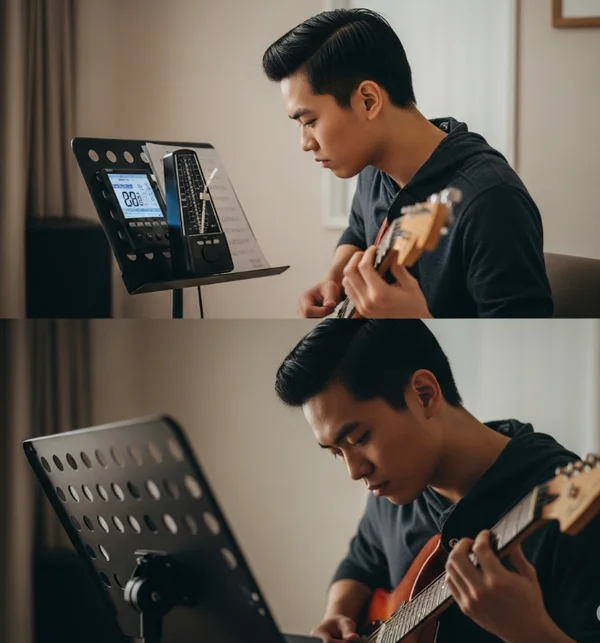هل يجب استخدام الميتونوم دائمًا؟ إيجابيات، سلبيات، وممارسة ذكية
الميتونوم الموثوق: بالنسبة للعديد من الموسيقيين، هو رفيق ممارسة لا غنى عنه. لكن السؤال الكبير الذي يطرح نفسه غالبًا هو: هل يجب عليك دائمًا ممارسة العزف باستخدام الميتونوم؟ يتطرق هذا النقاش إلى ممارسة الموسيقى الفعالة وإتقان الإيقاع. في حين أن استخدام الميتونوم باستمرار يوفر فوائد لا يمكن إنكارها، إلا أن النقر المتواصل قد لا يكون دائمًا هو الحل الأمثل. من المهم فهم إيجابيات وسلبيات الميتونوم. جرب ميتونومنا لترى كيف يمكن لأداة مرنة أن تناسب ممارستك.
حجة "الممارسة دائمًا مع الميتونوم": فوائد قوية لإيقاعك
متى يجب أن أستخدم الميتونوم لتحقيق أقصى فائدة؟ يوفر استخدام الميتونوم باستمرار مزايا رئيسية للموسيقى الجادة. إنها أداة قوية لـ التدريب الإيقاعي.
بناء توقيت ودقة متينين
واحدة من فوائد الميتونوم الأساسية هي تنمية توقيت لا تشوبه شائبة. تُجبر الممارسة باستخدام ميتونوم عبر الإنترنت على المحاذاة الدقيقة مع الإيقاع، مما يلغي التسرع أو التباطؤ للحصول على صوت مصقول. ستتعلم ترسيخ نبض ثابت داخليًا.

تنمية السرعة والتحكم المتسقين
تريد العزف بشكل أسرع بوضوح؟ يساعدك الميتونوم. يُساعد زيادة السرعة تدريجيًا خلال جلسات التدريب الخاصة بك على بناء السرعة مع الحفاظ على التحكم، مما يمنع العادات غير المنضبطة من المحاولات المتسرعة.
تحديد وإصلاح نقاط الضعف الإيقاعية
تكمن قوة الميتونوم في تسليط الضوء على عيوبك. غالبًا ما تكون لدينا نقاط عمياء إيقاعية. يكشف نبضه الثابت عن هذه التناقضات، مما يسمح بالتصحيح الموجه ويجعل ممارسة الموسيقى الخاصة بك أكثر كفاءة.
ردود فعل موضوعية: مدربك الإيقاعي المحايد
يوفر الميتونوم ردود فعل موضوعية ثابتة. إنه ببساطة يوفر إيقاعًا ثابتًا، مما يجعله ذا قيمة كبيرة للتقييم الذاتي. فكر في الأدوات المجانية عبر الإنترنت كمدرب إيقاع شخصي لك.
إيجابيات وسلبيات الميتونوم: متى يصبح النقر المستمر عكازًا
في حين أن الفوائد واضحة، هل من السيء استخدام الميتونوم دائمًا؟ يمكن أن يؤدي الاعتماد المفرط إلى عيوب، مما يعيق النمو الموسيقي والقدرة على تنمية الإيقاع الداخلي.
مخاطرة العزف الآلي: فقدان الموسيقية؟
يمكن أن يؤدي التركيز المفرط على الدقة إلى عزف آلي. تتضمن الموسيقى التعبير الموسيقي والظلال. قد يصعب دمج هذه العناصر البشرية إذا تم التدريب فقط بنقرات صارمة.

صعوبة تطوير نبض داخلي
هل يمكن أن يؤذي استخدام الميتونوم الموسيقية من خلال إعاقة ساعته الداخلية؟ نعم، إذا كانت هذه هي الطريقة الوحيدة التي تعيش بها الإيقاع. الهدف هو ترسيخ الإيقاع داخليًا، ليصبح ميتونومك الخاص. يمكن أن يعيق الاعتماد المستمر على نقرة خارجية هذا الأمر.
التحديات في العزف الجماعي والروباتو
في العزف الجماعي، خاصةً مع المرونة الإيقاعية (مثل الروباتو)، يمكن أن يكون الالتزام الصارم بالميتونوم مضرًا. يحتاج الموسيقيون إلى الاستماع والتعديل، وخلق إحساس جماعي بالوقت. يمكن أن يجعل الاعتماد المفرط ممارسة الموسيقى المرنة هذه أكثر صعوبة.
"إدمان الميتونوم": هل يمكنك العزف بدونه؟
يُطور بعض الموسيقيين "إدمان الميتونوم" – يشعرون بعدم القدرة على العزف في الوقت المناسب بدونه. هذا الاعتماد عقبة، خاصة في العروض. الهدف هو بناء المهارات، وليس تعزيز الاعتماد. تعلم كيفية التوقف عن الاعتماد على الميتونوم أمر أساسي.
متى نستخدم الميتونوم: لحظات استراتيجية لأقصى تأثير
إذن، متى يجب أن أستخدم الميتونوم؟ التطبيق الاستراتيجي هو المفتاح، واستخدامه عندما يوفر أكبر ميزة لـ تدريبك الإيقاعي.
تعلم مقطوعات جديدة أو مقاطع صعبة
عند معالجة موسيقى جديدة أو صعبة، يكون الميتونوم عبر الإنترنت ذا قيمة كبيرة. يسمح البدء ببطء بمعالجة النغمات والإيقاعات بدقة، مما يمنع الأخطاء المتجذرة.
التدريب الإيقاعي المركّز وتمارين الميتونوم المحددة
تحسن تمارين الميتونوم المخصصة مهارات إيقاعية محددة، مثل التقسيمات المعقدة أو المزامنة. يمكن أن تساعدنا مساعدات التدريب في إعداد هذه الأمور.

بناء السرعة بشكل منهجي (طريقة "السلم")
لزيادة سرعة العزف، استخدم الميتونوم كدليل. ابدأ بسرعة مريحة، مثالية. ثم، زد بمقادير صغيرة (2-4 BPM) بمجرد أن تصبح العزف خاليًا من العيوب. هذا يضمن تطوير سرعة متسقة ونظيفة.
جلسات التسجيل وإعداد الأداء
في التسجيل، غالبًا ما يكون مسار النقر (الميتونوم) ضروريًا للتناسق. يمكن أن يُرسخ استخدام الميتونوم في التحضير النهائي للأداء السرعة، خاصةً إذا كنت تستهدف BPM محددًا باستخدام عداد BPM.
إيجاد الحرية: متى تمارس بدون ميتونومك عبر الإنترنت
إن معرفة متى تُوقف الميتونوم أمر بالغ الأهمية لتعزيز ساعتك الداخلية وموسيقيتك.
تنمية إحساسك الداخلي بالوقت والإيقاع
في النهاية، أنت تريد تنمية الإيقاع الداخلي – إحساس فطري بالنّبض والشعور. تُنمي الممارسة بدون الميتونوم هذه القدرة الداخلية والثقة الإيقاعية.
ممارسة العزف التعبيري والروباتو
غالبًا ما ينطوي التعبير الموسيقي على انحرافات في السرعة (الروباتو). لممارسة هذه الانحرافات، ابتعد عن الميتونوم ودع الموسيقى تتنفس عاطفيًا.
التجريب والعزف مع موسيقيين آخرين
عند العزف مع الآخرين، يكون الاستماع والاستجابة أمرًا حيويًا. غالبًا ما يكون النبض المشترك أكثر عضوية من الميتونوم. تُحسّن الممارسة بدونه مهارات الفرقة.
اختبار تقدمك: هل يمكنك الحفاظ على الوقت بشكل مستقل؟
إن الممارسة دوريًا بدون الميتونوم هو اختبار ذاتي. هل يمكنك الحفاظ على سرعة ثابتة؟ سجّل نفسك دون النقر واستمع لتقييم ساعتك الداخلية.
تحقيق التوازن الصحيح: استراتيجيات ممارسة الميتونوم الذكية
تتضمن ممارسة الموسيقى الفعالة استخدامًا متوازنًا للميتونوم. الأمر يتعلق باستخدام هذه الأداة القيّمة بحكمة.
طريقة "تشغيل وإيقاف": التناوب مع وبدون
مارس مقطعًا مع الميتونوم، ثم على الفور بدونه. كرر لترسيخ التوقيت ثم قم بتكراره بشكل مستقل. تحقق من الدقة من خلال تشغيله مرة أخرى. هذا يعزز الدقة والاستقلالية.

استخدام ميتونومك عبر الإنترنت للأقسام، وليس الجلسات بأكملها
استخدم الميتونوم استراتيجيًا لأقسام محددة حيث يكون أكثر حاجة، وليس جلساتك بأكملها. جرب أداة الإنترنت من أجل هذه الممارسة المُستهدفة.
الاستماع مرة أخرى: تسجيل نفسك مع وبدون النقر
تسجيل نفسك أمر قوي. سجّل مع الميتونوم، ثم بدونه. يوفر الاستماع مرة أخرى رؤى حول توقيتك وأين قد يتعثر أو يلمع إيقاعك الداخلي.
ميتونومك، أداة لك - استخدمه بحكمة
هل يجب عليك دائمًا ممارسة العزف باستخدام الميتونوم؟ الجواب مُعقّد. إنها أداة قوية للتنمية الإيقاعية ولكن يجب أن تخدم أهدافك الموسيقية. فهم إيجابيات وسلبيات الميتونوم وتطبيق ممارسة موسيقية ذكية – معرفة متى نستخدم الميتونوم ومتى ننمّي ساعتنا الداخلية – أمر أساسي. الهدف هو العزف بإيقاع لا تشوبه شائبة، معبر، مع أو بدون الميتونوم.
ما هي تجارب ممارسة الميتونوم الخاصة بك؟ استكشف الميزات المرنة للميتونوم وإيقاع النقر الخاص بنا الميتونوم وإيقاع النقر لدعم رحلتك الإيقاعية!
أسئلة ممارسة الميتونوم الخاصة بك مُجيبة
كم من الوقت يجب أن أمارس مع الميتونوم كل يوم؟
ركز على الجودة. استخدمه لأهداف محددة، ربما 15-30 دقيقة من العمل المُركّز.
هل يمكن أن يؤذي استخدام الميتونوم كثيرًا موسيقيتي؟
نعم، إذا أدى ذلك إلى عزف آلي وأعاق إيقاعك الداخلي. التوازن هو المفتاح. ميتونومنا عبر الإنترنت هو مساعد مرن.
هل من الجيد البدء في تعلم آلة موسيقية بدون ميتونوم؟
في حين أن هذا ممكن، فإن إدخاله مبكرًا يساعد في بناء أساس إيقاعي قوي.
كيف أعرف ما إذا كنت أعتمد كثيرًا على الميتونوم؟
سجّل نفسك أثناء العزف بدونه. إذا كانت سرعتك غير متسقة، فقد تكون تعتمد عليه بشكل مفرط. مارس كيفية التوقف عن الاعتماد على الميتونوم تدريجيًا.
ما هي بعض تمارين الميتونوم الجيدة لتنمية الإيقاع الداخلي؟
اجعله ينقر فقط على الإيقاعات 1 و 3. أو استخدم طريقة "التشغيل والإيقاف". يُساعد أيضًا استكشاف التقسيمات الفرعية باستخدام أداة مثل إيقاع النقر عبر الإنترنت الخاص بنا.